What happened to the study of economics? RBA's Jacqui Dwyer
GUEST OBSERVATION
This is an edited extract from Jacqui Dwyer, head of the RBA's information department, address to the Business Educators Australasia Annual Meeting.
Education in Australia is receiving a lot of attention at present. Against the background of Australia's core learning skills at school, there is much debate among educators about what we should teach, how we should teach it and how we should assess it. In terms of ‘what’ should be taught, the current debate provides a good opportunity to raise awareness of economics as a valuable field of study.
Economics is relevant to us all. Every day our lives are affected by economic decisions – ones we make personally and ones that are made by others. Economics is about how individuals and societies choose to allocate their limited resources to meet their needs and wants. It's about how we respond to incentives, make trade-offs, weigh up costs and benefits – and how we decide what is efficient and what is fair. Economics contains some powerful concepts and useful frameworks. It can help us better understand the choices involved in many personal decisions we make, and better understand the economic conditions and policies that affect our lives.
Given the relevance of economics, and the social benefits of economic literacy, how widely is it studied? Be it at high school or university, economics was once widely offered and widely chosen – but that is no longer true. This is weighing on both the size and diversity of the student population, with implications for economic literacy and the longer-term health of the economics discipline in Australia.
The High School Scene
First, I want to remind you of some of the key features of the economics landscape at Australian high schools.
Nationally, there has been a dramatic decline in Year 12 economics enrolments over the past 25 years of around 70%. Our case study of enrolments in New South Wales (for which we have the most detailed data), shows an even greater fall of 75% over the same period. This fall was concentrated in the early 1990s when economics was displaced by the introduction of business studies in 1991 – arguably a less analytically demanding and vocationally oriented subject (Graph 1).
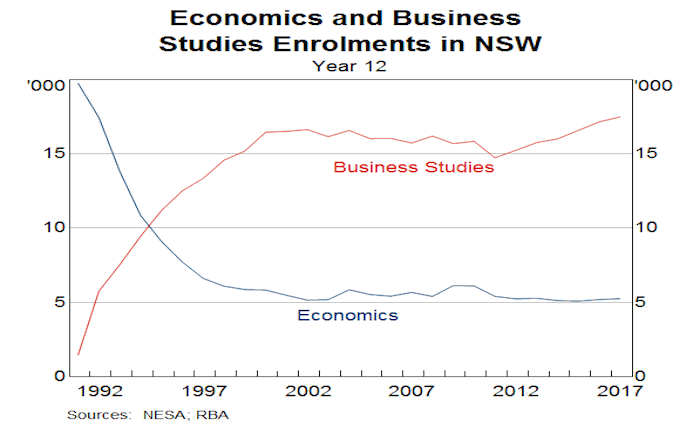
In 1991, economics was the third most popular subject choice in New South Wales, surpassed only by English and mathematics. It was also taught in nearly all schools. These days, we find that it is taught in less than one-third of government schools and a little over half of non-government schools. Consistent with economics now being less available as a subject choice in government schools, there are sharply declining economics enrolments, especially in the comprehensive schools that the majority of students attend (Graph 2).
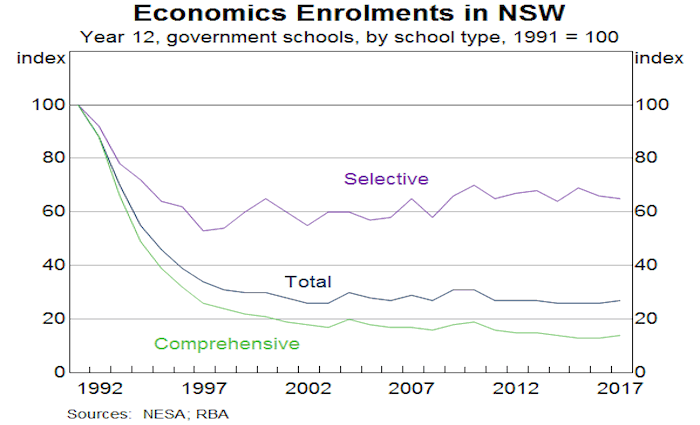
Another defining feature of the high school scene is the fall in the share of female students enrolled in economics. Again, in the early 1990s, there were roughly even shares of male and female students in economics classrooms, whereas these days there are roughly twice as many male students as female students (Graph 3). This gender imbalance is more pronounced than for STEM (science, technology, engineering and mathematics) and contrasts with the high and stable ratio of female to male students in the rival subject of business studies.
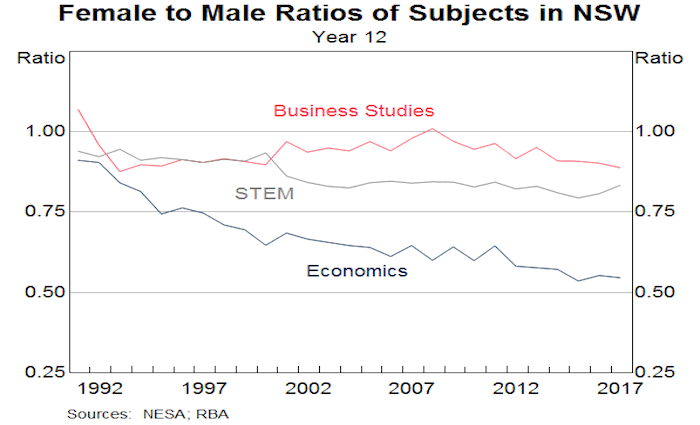
So over the course of a generation, there has been a pronounced fall in the size and diversity of the economics student population at Australian high schools. Has the same pattern been evident at universities?
The University Scene
In looking at university enrolments in economics, it is necessary to first establish what we mean by economics. At university, economics can be taken as a degree, a major or a subject within many different courses. We rely on each university's judgment about ‘how much economics’ counts as an economics enrolment when they report on this to the Department of Education and Training (DET).
Graph 4 compares economics enrolments in Australian high schools with university enrolments. It shows that while there has been a large fall in the level of economics enrolments at high school, economics enrolments at university have been fairly constant since the early 1990s and have fallen slightly since 2001 (when we have a series break in our data because the classification structure of subjects changed).
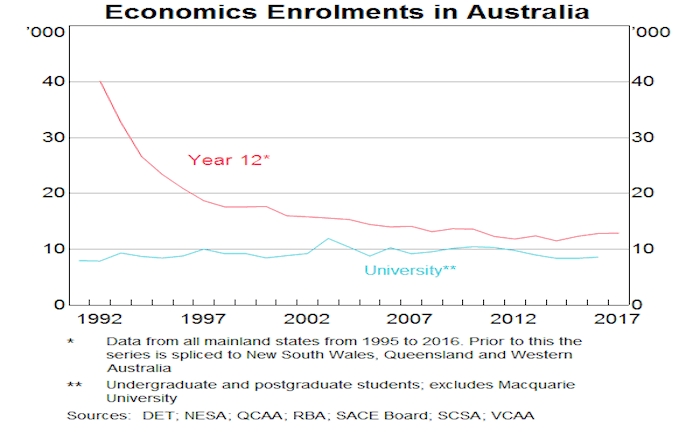
But how does this compare with growth in other subjects and the overall student population at university? Since 2001, while economics enrolments have edged down, enrolments in rival subjects have expanded, as has the total student population. In other words, economics is also being displaced at university by business-oriented subjects (banking, finance, management and commerce) and is lagging STEM in its ability to attract students (Graph 5). While these courses teach valuable skills, and some include similar skills to those learned in economics, economics students are a declining share of the university student population.
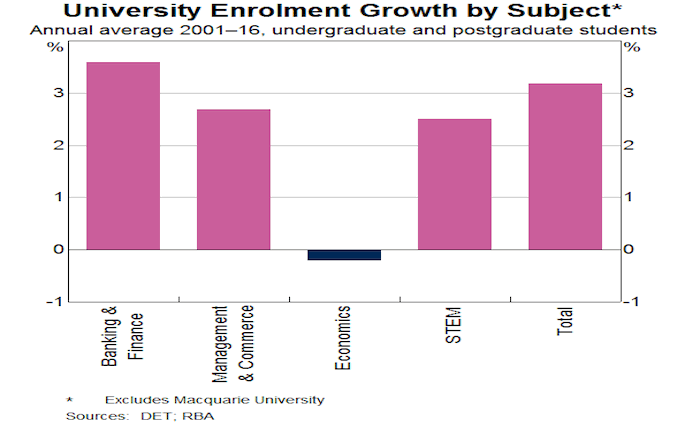
One question that my colleagues ask is whether the declining share of students studying economics at uni reflects declining demand for economists in the job market. We actually don't know much about the level of demand for economic skills. But we do know that fewer universities are offering economics and half of those that do are in New South Wales and the ACT (Graph 6). Institutional concentration is not necessarily a problem – those universities that continue to offer economics may have high-calibre programs and attract high-calibre students. However, such concentration will weigh on the diversity of the economics student population if these universities do not have inclusive approaches to accepting students. Furthermore, the need to relocate to study economics will be a barrier for some students who might otherwise have chosen the subject.
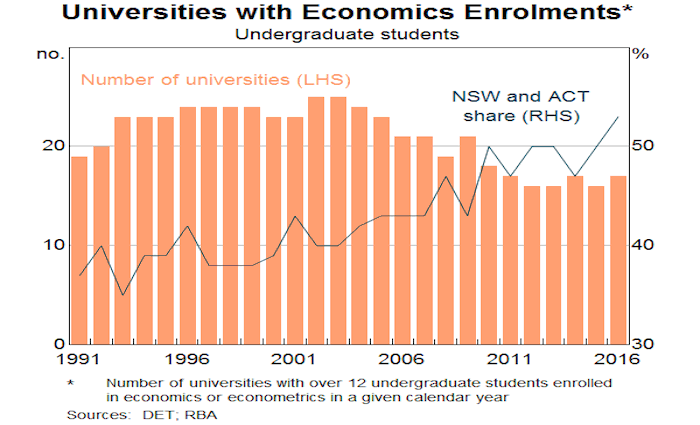
So let's look at some explicit indicators of diversity in economics. At university, there are more than twice as many male students as female students who study economics. And while there has always been a gender gap at university (unlike at high schools where gender balance once existed), this gap has widened over the past decade and is even more pronounced than presently at high school (Graph 7).
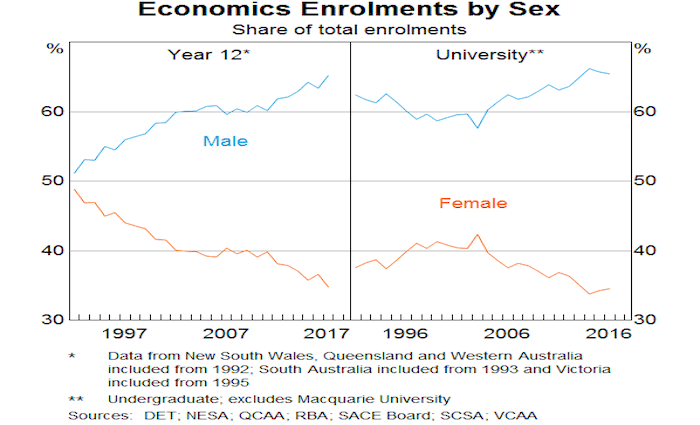
Another important element of diversity is socio-economic status. A striking feature of the university data is the share of students studying economics who come from high socio-economic backgrounds – currently over 55%. This share has been increasing over the past twenty years, just as it has for economics students at high school (Graph 8). Furthermore, the share of university economics students from backgrounds of high socio-economic status exceeds that for rival subjects, and it significantly exceeds that for STEM students and the student population overall (Graph 9).
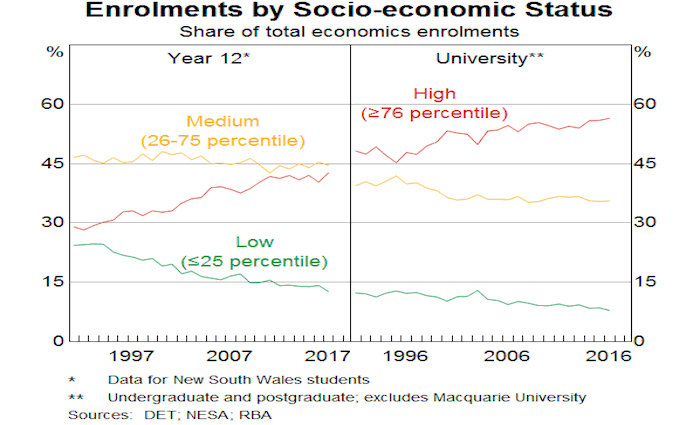
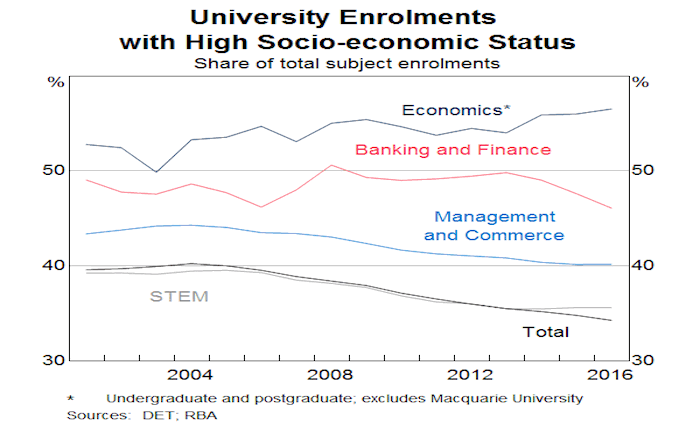
What's Wrong with This Picture?
It is of concern to see the drift toward a smaller and more homogenous population of economics students – both at school and university. The number of students who study economics influences the level of economic literacy in society. And the diversity of those students ultimately influences the collective ability of the economics profession. Diversity has bearing on the economic questions that we ask, our approaches to answering them how we action solutions. Because those who study economics shape the discipline and determine economic policies, there are wider social benefits when the population of economics graduates is broadly representative of society.
The importance of diversity in the study of economics is increasingly being voiced by central bankers. The Chief Economist of the Bank of England, Andy Haldane, has been vocal about this issue. So too have researchers Amanda Bayer and David Wilcox who, in a US Federal Reserve discussion paper, identify pervasive imbalances in economics education in the United States and argue that this is a matter that warrants urgent attention.
So what has been driving the fall in size and diversity of Australia's economics student population? A number of forces are at work. To help inform the Bank's public education program, we have done a lot of data analysis and liaison with educators, education authorities and students. There are some dominant themes.
Economics has become less prominent. In the 1980s and early 1990s, economics was the subject of national debate. There was the lived experience of recession and big economic events like the floating of the dollar and the deregulation of labour and financial markets. So prevalent was the discussion of economics that former Prime Minister Paul Keating once said ‘I guarantee if you walk into any pet shop in Australia, the resident galah will be talking about microeconomic policy’. With Australia having experienced over a quarter of a century of continuous economic expansion, there is now a less involving – and less mature – national conversation about economics.
A relatively benign economic environment appears to have reduced the curiosity of students in seeking to learn about economics. However, the single largest factor weighing on the study of economics appears to have been the emergence of business studies as a subject choice in schools, and the growing dominance of business schools at universities.
When compared with rival subjects, economics has an image problem. Too few students understand what economics is and how it is relevant to them. Consequently, in a cluttered curriculum – at both high school and university – they are less likely to choose it. And if economics is no longer a core subject in many courses, the incentives to choose it fall further.
A key consideration in making a subject choice is its employability, especially given the effort and expense involved in investing in education. Many students - and importantly their parents - consider economics to be less employable than business-oriented subjects. They value subjects and degrees with a clear pathway to a specific occupation (e.g. by studying accounting you can become an accountant). However, the data tell us that graduate starting salaries are higher for economic students than students who take business-oriented subjects and that full-time employment rates are broadly similar. In fact, the sorts of skills acquired in the study of economics – such as analytical and problem solving skills – are likely to be highly valued as the nature of work changes (as explained by the Bank's Head of Economic Analysis, Alex Heath, in her speech on Skills for the Modern Workforce). It is perhaps because economics graduates are less likely to be employed in their subject field that the misperception about employability arises.
Role models are also important, and the lack of visibility of what an economist does results in a shortage of role models. Furthermore, to the extent that economists are visible, too often they are a homogenous bunch. This can have the effect of discouraging students, particularly females and those from minority backgrounds.
The lack of diversity in the economics profession speaks to implicit biases that also manifest themselves in the presentation of economic content – ranging from the lower rates of success in publication experienced by female economists, through to lower representation of females in economic examples in textbooks. Much has been made in recent years of the fact that females (or minority groups) rarely appear in textbooks, other than in stereotypic roles. This can be discouraging to female students and others who are not represented.
But in addition to all these factors that influence the choices a student might make, there are disincentives facing schools and universities in offering economics.
At the end of the day, schools and universities need to think about the value proposition of offering subjects. At high schools, where the fall in enrolments has been dramatic, principals need to assess whether economics enrolments are at a critical mass to support classes. They also need to have teachers who are equipped to deliver these courses. Over the past 20 years there has been a decline in the number of teachers who have themselves studied economics at university. With teachers increasingly teaching economics ‘out of field’, their confidence in delivering economics courses can be low.
Teaching economics at school is difficult. The concepts are analytically challenging and the script is always changing, given the need to include current economic conditions. The requirement for teachers to be across economic developments is demanding, especially if they are teaching out of field. Business studies, on the other hand, is easier to teach and has the (incorrectly) perceived benefit of greater employability. Consequently, in many schools, teaching resources have been allocated to business studies rather than economics.
Universities are faced with similar decisions about allocating resources. Additionally, their choices are influenced by government decisions that affect teaching revenue. Most domestic undergraduate students occupy ‘Commonwealth supported places’ where fee revenue is made up of a student contribution plus a government contribution. Economics is in the unfortunate position of being in the course group (along with law, commerce, accounting and administration) that has the highest student contribution and the lowest government contribution (Graph 10).
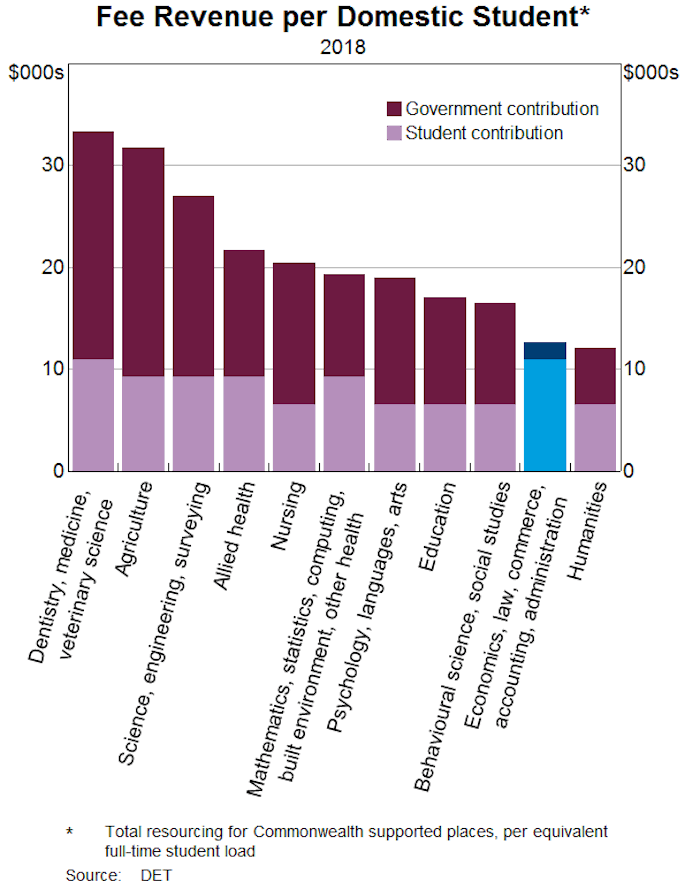
On top of this, analysis by Deloitte Access Economics suggests that, on average, universities only roughly break even in delivering economics to domestic students. But universities gain substantial revenue from courses offered to overseas students (where fees for economics and business courses can be twice those charged to domestic students). The business-oriented courses of commerce and management in Australia now attract around one-third of total overseas student enrolments; in fact, in 2015, there were 70 overseas students enrolled in commerce and management for every overseas student enrolled in economics. Consequently, business schools have been described as the ‘cash cows’ of Australian universities with large profits that are redistributed to fund other university activities, encouraging administrators to focus on offering business courses over economics.
The decision of administrators to favour business courses over economics is reinforced by lower completion rates in economics than in rival courses and university courses overall. Economics also disappoints on other metrics considered by administrators, such as rankings in research output.
A combination of these factors has left an entire generation of students less engaged with economics, less educated about it and potentially less equipped to understand or react to changes in their economic environment.
The Bank's Response
The Bank has always been committed to supporting people who want to learn more about economics and the Australian economy. Our observations about developments in economics education encouraged the establishment of the Bank's public education program. The program is still in its infancy, and we are grateful to you for the role you have played in helping us understand the needs of educators and students as we develop our educational resources and activities. In the course of doing this, we have learned much about how inaccessible economics can be and how much needs to be done to address that.
We have developed a series of resources that are designed to support students and educators, as well as being relevant for more general audiences. You can see these on the education section of the Bank's website. Our Ambassador program is well established with a group of young Bank economists delivering talks to students and educators across the country, including going into classrooms. We are out and about more, explaining what economics is, providing insights into what we do as economists and hopefully providing some useful role models. (This includes promoting awareness of role models outside the Bank, such as prominent Australian women in economics.)
On more formal aspects of our program, we have made a submission in support of economics being included in the middle years of high school in New South Wales. And the Bank is now an accredited provider of professional development for economics teachers. In fact, we look forward to seeing some of you at our annual Teacher Immersion Event next month.
Economics is relevant to students in many ways that they may not explicitly recognise. Students have great interest in understanding their own material welfare and that of society more broadly. They are interested in the personal and collective choices that determine such welfare, now and in the future. This all relates to economics. We need to make students aware of the ways in which economics can inform and empower them.
From improved economic literacy in the community, through to improved design of public policies, economics education delivers significant social benefits. In other words, there are civic returns to studying economics. Your role in encouraging that study is very important.
Jacqui Dwyer is head of the Reserve Bank of Australia's information department.
For the original speech, click here.
